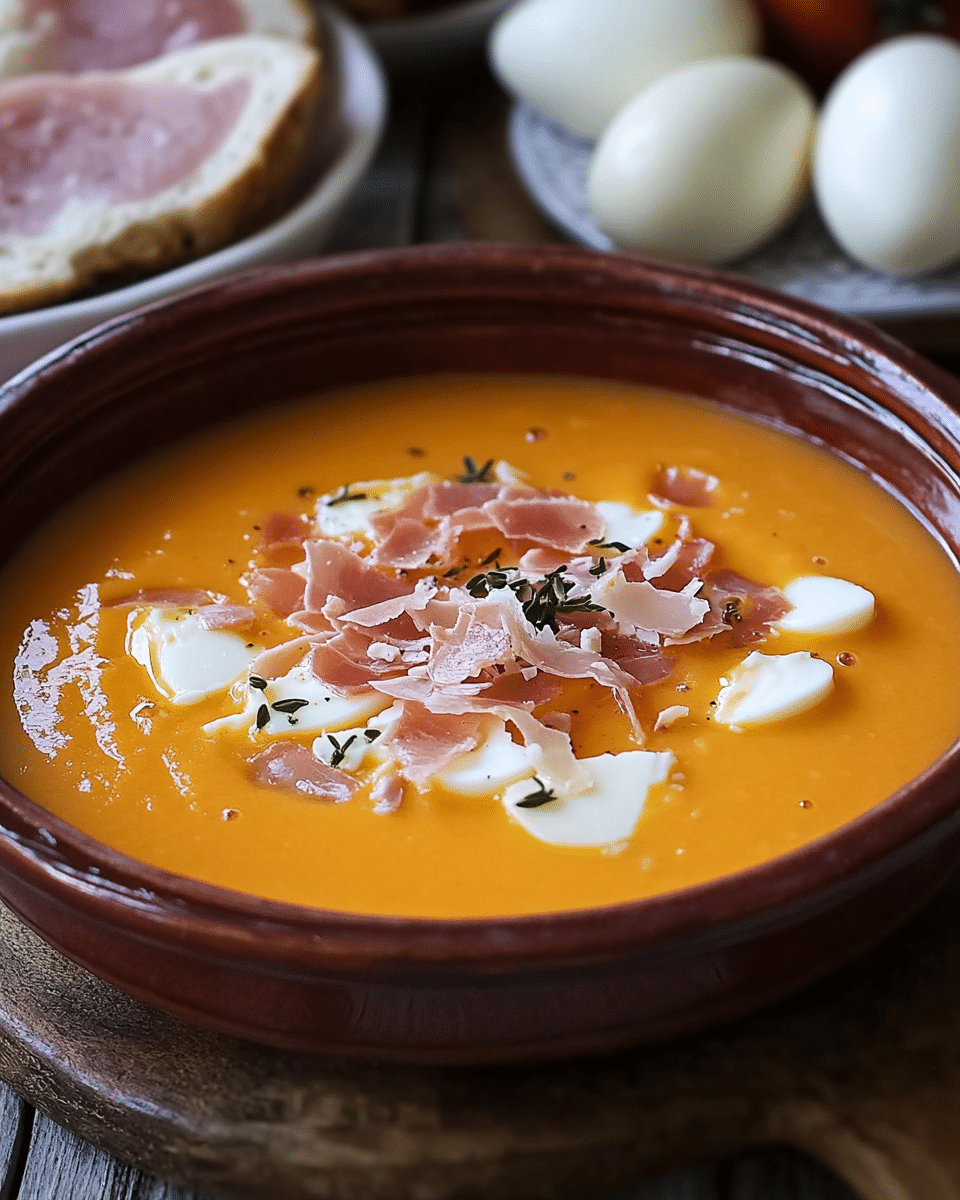Salmorejo is a creamy, cold tomato soup that hails from the sun-soaked region of Córdoba, Spain. Rich in ripe tomatoes and thickened with bread, this dish is a quintessential part of Andalusian summer cuisine. Unlike its cousin gazpacho, Salmorejo is smoother and richer, traditionally topped with hard-boiled eggs and strips of salty Jamón Serrano for a perfect balance of textures and flavors.
This chilled delight is wonderfully simple yet deeply satisfying, ideal for hot weather when lighter, refreshing meals are preferred. The creamy texture of the soup pairs beautifully with the savory toppings, creating a dish that is both rustic and elegant. Whether served as an appetizer or light lunch, Salmorejo captures the essence of Mediterranean simplicity and authenticity.
Full Recipe:
Ingredients:
-
1 kg ripe tomatoes
-
200 g stale white bread (crust removed)
-
1 garlic clove
-
100 ml extra virgin olive oil
-
1 tablespoon sherry vinegar
-
Salt to taste
-
2 hard-boiled eggs (for garnish)
-
50 g Spanish Jamón Serrano or Prosciutto (thinly sliced, for garnish)
Directions:
-
Wash and core the tomatoes. Cut into chunks.
-
Place the tomatoes in a blender and process until smooth.
-
Pass the purée through a fine sieve into a bowl to remove skins and seeds.
-
Add the bread to the tomato purée and let it soak for 10 minutes.
-
Add garlic, olive oil, vinegar, and a pinch of salt to the soaked bread and tomato mixture.
-
Blend everything until the soup is creamy and velvety. Taste and adjust salt if needed.
-
Chill in the refrigerator for at least 1 hour before serving.
-
Serve cold, topped with chopped hard-boiled eggs and thin slices of Jamón Serrano or Prosciutto.
Prep Time: 15 minutes | Cooking Time: 0 minutes | Total Time: 1 hour 15 minutes (including chilling)
Kcal: 250 kcal per serving | Servings: 4 servings
Salmorejo: The Creamy Andalusian Tomato Soup Perfect for Summer
When the warm summer months arrive, there is nothing more refreshing and satisfying than a chilled bowl of Salmorejo, a traditional Spanish tomato soup that hails from the sun-drenched city of Córdoba, located in the southern region of Andalusia, Spain. Much like its better-known cousin, gazpacho, Salmorejo is served cold, but it offers a thicker, richer, and creamier texture, thanks to its clever use of bread and olive oil.
If you’ve never tried Salmorejo before, prepare to fall in love with its simple ingredients, incredible flavor, and luxurious consistency that dances on the palate with every spoonful. Not only is this soup a delight for the taste buds, but it also carries centuries of Spanish culinary history in each serving. Whether you serve it as an appetizer, light lunch, or main dish with toppings, Salmorejo brings the soul of Andalusia right to your kitchen table.
What is Salmorejo?
Salmorejo is a cold, creamy soup made primarily from fresh ripe tomatoes, stale bread, garlic, sherry vinegar, and high-quality extra virgin olive oil. This combination results in a silky smooth texture that distinguishes Salmorejo from other tomato-based soups. The final dish is usually garnished with finely chopped hard-boiled eggs and slivers of Jamón Serrano or Prosciutto, adding protein, texture, and a savory depth that balances the sweetness and acidity of the tomatoes.
This dish’s origins are deeply rooted in Andalusian cooking traditions, where simple, humble ingredients were transformed into deeply flavorful dishes that required no cooking, making it ideal for the hot climate. Salmorejo is believed to have evolved from the Roman practice of making “salmor” (a bread and liquid paste), later adapted by Andalusian locals with their abundant tomato harvests.
The Difference Between Salmorejo and Gazpacho
While both Salmorejo and Gazpacho are beloved chilled soups of Spain, they are distinct in texture and flavor. Gazpacho typically includes a variety of vegetables such as cucumbers, bell peppers, onions, and garlic, giving it a chunkier, more rustic consistency with a zesty, slightly acidic kick.
Salmorejo, on the other hand, focuses solely on tomatoes as the main vegetable ingredient and is thickened generously with bread. The olive oil emulsifies during blending to create a velvety, almost creamy texture. Where gazpacho is refreshing and vegetable-forward, Salmorejo is dense, rich, and satisfying, perfect for a filling summer meal.
Key Ingredients Explained
1. Ripe Tomatoes
Tomatoes are the star of this dish, so choosing the ripest, juiciest tomatoes is essential. In Spain, pear tomatoes (tomate pera) are often used for their balanced sweetness and low water content, but Roma or vine-ripened tomatoes are excellent alternatives.
2. Stale White Bread
Traditional Salmorejo uses day-old, crustless white bread, which is soaked in tomato juice to achieve the creamy consistency. This clever use of stale bread highlights the dish’s roots in peasant cuisine, where food waste was minimized.
3. Garlic
A single clove of garlic adds just enough kick without overpowering the fresh flavor of the tomatoes. Use fresh garlic, but in moderation, as its sharpness can quickly dominate the dish.
4. Sherry Vinegar
The acidity of Spanish sherry vinegar (Vinagre de Jerez) balances the soup’s richness and provides a touch of authentic Andalusian flavor. If unavailable, apple cider vinegar can be substituted.
5. Extra Virgin Olive Oil
A generous pour of the finest extra virgin olive oil is a must. The oil emulsifies with the tomatoes and bread, creating the soup’s famously creamy mouthfeel and golden sheen.
6. Toppings: Hard-Boiled Eggs and Jamón Serrano
To finish, Salmorejo is garnished with chopped hard-boiled eggs for protein and texture, along with thin slices of Jamón Serrano (or Prosciutto if Serrano ham is unavailable), adding a salty, savory contrast to the soup’s smoothness.
Health Benefits of Salmorejo
Despite its creamy taste, Salmorejo is surprisingly healthy and nourishing. Tomatoes are packed with vitamins A, C, and K, as well as the powerful antioxidant lycopene, which is linked to heart health and cancer prevention. The olive oil contributes healthy monounsaturated fats that support cardiovascular health, and the eggs add high-quality protein and essential nutrients like choline.
When made without Jamón and served with just the egg, Salmorejo can also be a vegetarian-friendly dish. Additionally, gluten-free bread can be used to adapt the recipe for gluten-intolerant individuals without sacrificing flavor or texture.
Tips for the Perfect Salmorejo
-
Use ripe, seasonal tomatoes for maximum flavor. Off-season or pale supermarket tomatoes won’t give you the deep, sweet taste this dish requires.
-
Chill the soup for at least an hour before serving, it’s best enjoyed cold, allowing the flavors to meld.
-
Add the olive oil slowly while blending to ensure proper emulsification and the desired creamy consistency.
-
Experiment with toppings! Besides eggs and Jamón, consider adding roasted vegetables, smoked salmon, or even avocado slices for a modern twist.
-
Make a large batch, Salmorejo keeps well in the fridge for 2-3 days and can be a delicious quick lunch or light dinner on hot days.
Salmorejo in Spanish Culture
Salmorejo is more than just a dish; it’s a culinary symbol of Córdoba and Andalusian heritage. It is commonly served in tapas bars across southern Spain and is a staple at family gatherings, especially during the scorching summer months.
The dish is so beloved that Córdoba hosts an annual “Salmorejo Festival”, where local chefs and home cooks showcase their unique variations of this timeless recipe. Visitors and locals alike revel in the refreshing, satisfying bowls of creamy tomato goodness, celebrating the simplicity and richness of Spain’s culinary traditions.
Why You Should Make Salmorejo at Home
Salmorejo is a budget-friendly, low-effort, high-reward dish that requires no stove time, making it ideal for warm days when you’d rather avoid heating the kitchen. With only a few pantry staples and fresh produce, you can create a restaurant-quality dish that wows guests and family alike.
This soup also offers endless room for creativity. Whether you stick to the traditional egg and Jamón garnish or explore modern toppings like vegan cheese, nuts, or grilled shrimp, Salmorejo is a versatile canvas that welcomes personalization.
Serving Suggestions
-
As an elegant starter at a summer dinner party.
-
Served in small glasses as a refreshing appetizer or amuse-bouche.
-
As a light main course with a side of crusty bread or salad.
-
Topped with extra veggies or seafood for a hearty lunch option.
Pair it with a crisp Spanish white wine or rosé, and you have the perfect Mediterranean meal.
Possible Variations
-
Vegan Salmorejo: Omit the egg and ham; top with roasted chickpeas or smoked tofu.
-
Gluten-Free Salmorejo: Use gluten-free bread or almond flour to thicken the soup.
-
Spicy Salmorejo: Add a pinch of cayenne pepper or smoked paprika for a little heat.
-
Avocado Salmorejo: Blend in half an avocado for an extra creamy and nutritious version.
Conclusion
Salmorejo is more than just a recipe, it’s a taste of Spain’s warm and welcoming culture, served in a bowl. Its simplicity, flavor, and rich texture make it a standout dish that appeals to all palates, from adventurous foodies to picky eaters. Whether you’re serving it as part of a Spanish tapas spread or enjoying it as a cooling lunch on a hot day, Salmorejo delivers both comfort and refreshment in every bite.
This dish is a testament to the magic of Mediterranean cooking: transforming humble, everyday ingredients into something truly extraordinary. Don’t wait for a trip to Spain, bring the flavors of Córdoba into your home kitchen with this easy, delicious, and timeless recipe.






